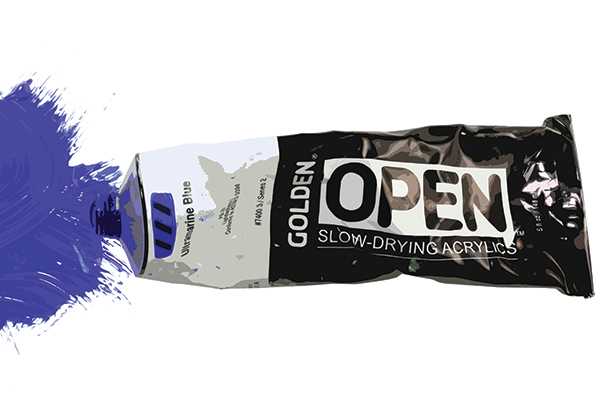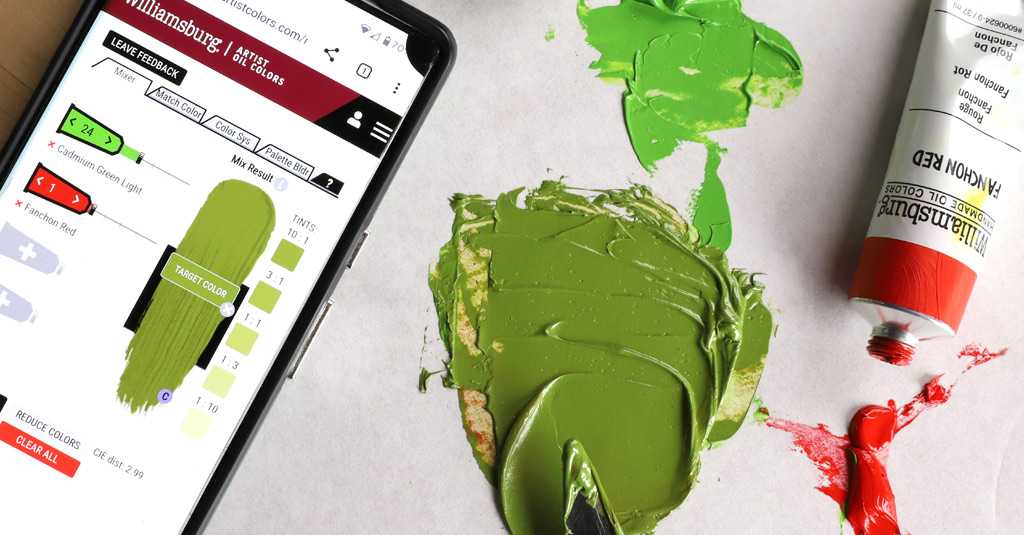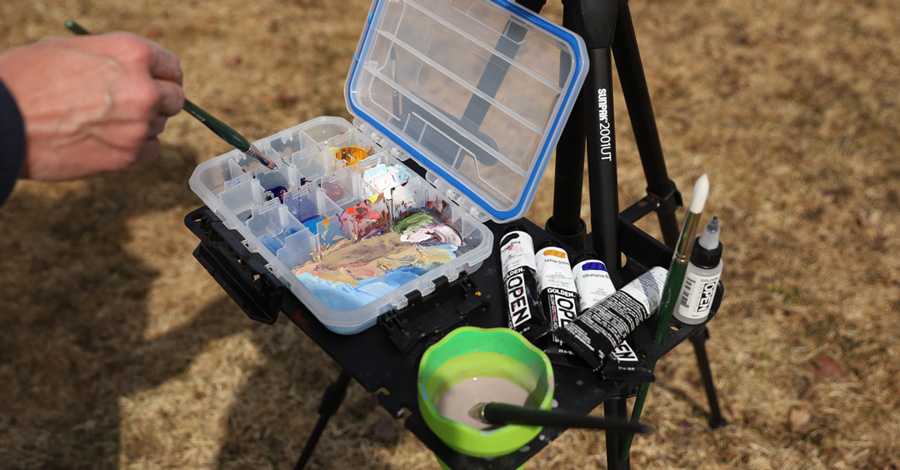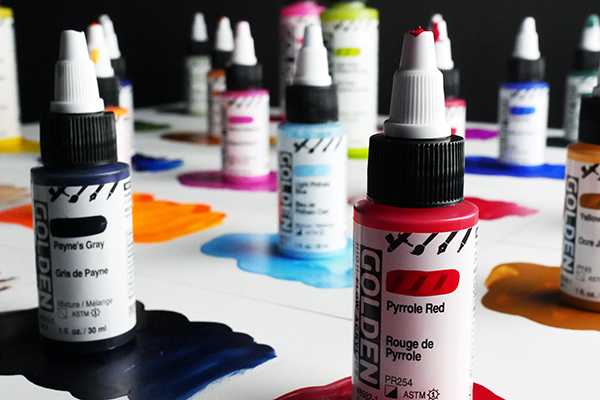PRODUCT DESCRIPTION
OPEN Acrylics are colors for professional artists designed with a unique set of working properties that represent a true departure from all other acrylics on the market and dramatically expand the range of techniques that are available to artists.
OPEN Acrylic Colors are formulated with an optimum balance of pigment load and 100% acrylic polymer dispersion to produce a paint with a uniquely relaxed set of working characteristics and a versatility that allows artists to explore a wider range of techniques such as portraiture and landscape painting that rely on softening, shading, glazing, and creating fine detail.
OPEN Acrylics remain wet on the palette for prolonged periods without skinning over and can be blended with most GOLDEN Acrylics, Mediums and Gels, with the open time of the resulting mixtures being proportionately reduced. To maintain the maximum working time of OPEN Acrylics, use OPEN Gel, Medium and Thinner.
PRODUCT APPLICATION
Layering and Blending
OPEN Acrylics lend themselves to both layering and blending in some ways that are reminiscent of oils. Thin applications of OPEN Acrylics can be blended for extended periods, allowing one to develop smooth transitions and to manipulate edges. They can be thinned with either water or OPEN Thinner. When used in conjunction with OPEN Thinner, which is formulated to replenish volatile components and maintain the long working time, OPEN Acrylics can be kept wet and blendable for many hours and even days. OPEN Gel or Medium can also be added at any ratio to help maintain the working time while modifying transparency, sheen, or viscosity.
Over time, thin applications will pass through several stages where the paint will begin to slowly set up and its tack increases. During this time, which can last for many hours, subsequent applications of any OPEN products or water can continue to reopen layers and allow one to continue blending and developing complex passages and fine details.
OPEN Acrylic Colors are best used in thin layers. Applications of more than 1/16 inch / 1.5 mm (wet film thickness) will result in:
- Excessively long drying periods
- Persistently soft, higher tack feel
- Translucent layers that remain cloudy
For thick applications, regular GOLDEN Acrylic Colors and Mediums are strongly recommended.
Layering OPEN With Faster Drying Acrylic Products
It is best to allow films containing OPEN Gel or Medium to dry fully before applying faster drying layers on top. Since volatile materials in OPEN evaporate slowly, faster drying layers can easily entrap these materials and delay the time when the layers will fully adhere to each other. While ultimately all layers will coalesce and develop full adhesion, quickly interleafing faster and slower drying layers can cause some of those layers to display early adhesion failure if pulled on, as can happen in hard-edge techniques that use masking tape.
Do not apply thick films of faster drying gels on top of applications of OPEN Acrylics, Gel, or Medium without waiting for a minimum of two weeks after being touch dry. This extended period is needed to avoid the volatile materials that might still be evaporating from the underlying materials from causing these faster drying gel applications from remaining cloudy or hazy.
Using With GOLDEN Acrylic Colors, Gels and Mediums
OPEN Acrylic Colors may be mixed in any ratio with nearly the full range of GOLDEN Acrylic Colors, Gels, Pastes, and Mediums. Resulting drying time will be dependent on the ratio. For exceptions please see the section:
Ongoing Research
Mixtures with standard acrylic products should follow the same guidelines as OPEN Acrylics, including keeping applications thin. See the above section on Product Application for more information.
There are also major advantages to be gained by using these two systems together. GOLDEN Acrylics, Gels, Pastes and Mediums are perfect for creating faster drying underpaintings and textures, which can then be overpainted with OPEN Acrylics, taking advantage of their optimal working time to achieve smoother blended passages, glazes, nuanced edges, and a host of other effects.
Rewetting OPEN Acrylic Colors
OPEN Acrylics can be reactivated for many hours after initial application, allowing for extended periods when multiple layers can be worked and blended into each other. To reopen films before they have fully locked downi, apply OPEN Gel or Medium directly to the paint film, brushing back and forth until the paint has been reconstituted. Even after OPEN paint films have initially set up and become tacky, they can still be reactivated, although more extended or vigorous brushing might be required. Using OPEN Gel or Medium for this process will help maintain film integrity and provide maximum working time. While water and OPEN Thinner are also usable, they are very aggressive at reactivating OPEN paint films and should be used sparingly to prevent partially dried films from lifting altogether.
To avoid reactivating underlying paint films, use a light touch when painting over recently worked areas. If ones methods require more substantial protection, wait for these layers to lock down, which can take several hours or even days depending on application thickness and environmental conditions.
To more quickly isolate layers from potential reactivation by subsequent applications, apply a thin, faster drying coating such as GAC 500, Fluid Matte Medium, or our standard isolation coat recipe of Soft Gel (Gloss) thinned 2 parts gel to 1 part water. However, as mentioned earlier, this will potentially slow the timeline for the development of full inter-coat adhesion.
The Sweet Spot
Unlike traditional acrylics, OPEN Acrylics undergo an extended period without skinning over that allows its tactile qualities to pass through distinct stages, the initial slippery and oily feel becoming gradually more pully and stiff. Along this gradient many painters will find what is often termed a sweet spot that suits their particular technique. Indeed, once this sweet spot is located, one can eventually control and maintain those qualities both on the palette and on the surface of the painting itself. While this is something that oil painters have long enjoyed, acrylic painters will find this a unique and wonderful opportunity to further control the textures and effects one can employ.
Thinning
OPEN Acrylics can be thinned and extended with OPEN Thinner, OPEN Medium, water, or other GOLDEN Mediums. For most painting techniques the following guidelines are recommended:
- OPEN Thinner will reduce the viscosity while still preserving the optimal working time. Since OPEN Thinner contains no binders, limit additions to a maximum 3:1 ratio of 3 parts paint to 1 part OPEN Thinner to maintain film integrity. OPEN Medium is useful when a more fluid application is desired while maintaining the working properties and extended open time. Can be added in any ratio.
- Water will very rapidly reduce the viscosity of the paint, but will not preserve the extended open time. To maintain film integrity limit additions to a maximum 2:1 ratio of 2 parts paint to 1 part water.
- Faster drying GOLDEN Mediums can be added in any ratio to OPEN Acrylics to modify viscosity as well but will lower the open time in proportion to the ratio.
For washes and stains on porous and absorbent grounds, one may exceed the above ratios, although the resulting paint films will become increasingly fragile and water sensitive. To later preserve these works, they will need to be properly framed and protected in ways similar to watercolors, or the surface will need to be consolidated with a layer of acrylic medium or an isolation coat prior to varnishing.
Modifying Viscosity, Opacity and Sheen
Use OPEN Gel, Medium, and Thinner to alter the viscosity, transparency, and flow of OPEN Acrylics while maintaining their optimal working time. OPEN Gel and Medium can be added in any ratio, while additions of OPEN Thinner should not exceed 3 parts paint to 1 part Thinner. As most OPEN Acrylics will dry to a satin-like sheen, mixing with OPEN Gel and Medium will also increase the overall gloss.
Faster drying GOLDEN products can also be used, keeping in mind that these mixtures will reduce the overall drying time of the resulting blend. To increase opacity, mix with GOLDEN Acrylic Colors or GOLDEN Pastes. To alter sheen, use any of the GOLDEN Gels and Mediums. Alternatively, the sheen can be modified at the level of a topcoat or varnish.
DRYING TIME
Drying times are very dependent on environmental conditions and individual results can vary. Under ambient conditions of 70ºF/21ºC and 30% RH, OPEN Acrylics will have an average working time that is approximately 10 times longer than the usual acrylic paints. Below is a table showing some test results on gessoed cards:
Paint film thickness: 6 mil (roughly equivalent to a thin brushstroke)
| Wetii | Workableiii | Can still be reopenediv | Touch dryv | Locked downi | |
| OPEN Acrylics | 30-60 min. | 1-3 hrs. | ~12 hrs. | 24+ hrs. | 14+ days |
| HB Acrylics | <5 min. | ~ 10 min. | n/a | ~30 min. | 3+ days |
| 1:1 OPEN and HB | 10-20 min. | 15-30 min. | 1-2 hrs. | 3-5 hrs. | 10+ days |
Use OPEN Mediums and Thinner to control viscosity while maintaining the maximum working time. To accelerate drying time, OPEN Acrylics may be blended with faster drying GOLDEN Acrylics, Gels and Mediums.
Because of the slow drying nature of these paints, it is recommended that work be left to dry for a minimum of 30 days before varnishing. During this period, it is also important to keep the artwork in a dust free environment, as the tacky phase of drying can cause small particles to become stuck and sometimes trapped.
The drying time of OPEN Acrylics can be accelerated by increasing airflow, careful use of moderate heat sources such as hair dryers, or controlling the environmental conditions to maintain a higher temperature and low relative humidity. For additional information see the following Application Information Sheet:
Technical Notes On Drying.
PALETTE MANAGEMENT
Non-Absorbent Palette During Working Sessions
OPEN Acrylics will stay usable on a non-absorbent palette, such as glass or enamel butcher trays, for extended periods of hours and even days without using additional retarders or moisture-retaining inserts by simply covering the palette when not in use. However, depending on the environmental conditions, some thickening of OPEN Acrylics can occur in the course of painting. Some artists have used this natural thickening of the paints as a method of creating a different working consistency without adding a medium. See earlier section on Sweet Spot for more information.
When using non-absorbent palettes the following guidelines will help maintain the working time and blendability of OPEN Acrylics:
- Mist with OPEN Thinner every 1-4 hours to avoid skinning of paint films.
- Alternatively, mist with water every 15-30 minutes.
- Thin paint mixtures can also be reopened for 8-12 hrs. by applying any of the OPEN products and brushing back and forth until reactivated.
Left unattended, and under typical ambient conditions, a dollop of paint roughly the size of a small marble could exhibit noticeable surface thickening within 2-4 hrs. However, if misting with Thinner, similarly sized dollops were still usable after 24 hrs., with only slight skinning due to a 12 hour period of drying overnight.
Non-Absorbent Palettes Stored While Covered
By simply covering a non-absorbent palette, such as an enameled butcher tray, or placing your palette in an enclosed storage container, even wet mixtures of OPEN Acrylics will stay soft and useable for many days if not weeks. If areas feel tacked up, small additions of OPEN Thinner should easily revive them.
Misting the palette beforehand with either water or OPEN Thinner will further extend these periods as well as help mixtures of OPEN Acrylics with faster drying GOLDEN Acrylics stay useable. Although both OPEN Thinner and water alone are helpful, OPEN Thinner is generally more effective and is our recommendation.
The ability of mixtures of regular GOLDEN and OPEN Acrylic Colors or Mediums to remain useable will be very dependent on the ratios of the mixtures and whether they have been misted with OPEN Thinner or covered with a layer of OPEN Medium. In most cases these should do quite well for a period of days. However, dollops of pure Fluid and Heavy Body Acrylics might become heavily skinned over or unusable over the same period.
CLEANING
Clean-up of brushes, tools, and palettes are far easier when using OPEN than traditional acrylics. With the extended open time, brushes that have been unintentionally left out for many hours can still be readily cleaned. Should the paint have tacked up or become stiff or even recently dried to the touch, soaking the brushes in OPEN Thinner will facilitate the removal of the paint. Afterwards, use soap and water to complete cleaning, repeat if necessary.
SUBSTRATES AND POTENTIAL S.I.D. ISSUES
OPEN Acrylics can be used on the same substrates as standard acrylics. However, because they are extremely slow drying, using OPEN Acrylics, Gel, and Medium on substrates containing high levels of water soluble impurities, such as many hardboard wood panels commonly referred to as Masonite®, leads to concerns of Support Induced Discoloration (S.I.D.). This is especially true with thicker translucent layers or paints and mediums that are kept wet for extended periods, allowing moisture ample time to penetrate the substrates and draw out impurities. Because of this, we strongly recommend using MDO (Medium Density Overlay) or furniture grade Birch plywood when painting on wood. In addition, our best recommendation for preparing wood supports for use with OPEN Slow-Drying Colors and Mediums:
- BEST: 3 coats of GOLDEN Gloss Medium followed by one or more coats of GOLDEN Gesso
- GOOD: 3 coats of GOLDEN GAC 100 followed by one or more coats of GOLDEN Gesso
- NOT RECOMMENDED: Shellac-based primers or sealers.
For more information see our Just Paint article, OPEN Acrylics, Shellac, and SID
VARNISHING
In order to assure all volatile materials have completely evaporated, work using OPEN Gel and Medium should dry for a minimum of 30 days prior to the application of varnish, and a minimum of 2 weeks before the application of an isolation coat. Paintings using thicker films, or a large number of layers applied in a relatively short period, may require a longer drying time.
Prior to the use of a suitable varnish, such as GOLDEN Polymer Varnish, apply one or more layers of GOLDEN Isolation Coat. This will greatly reduce the chance of lifting paint during varnish application or future removal. Allow 24 hours between Isolation Coat layers and up to 72 hours before varnishing.
For more information please refer to the following Application Information Sheet:
Varnish Application Guidelines
EXTERIOR MURALS AND SCULPTURES
We Do Not Recommend the use of OPEN products for any exterior applications where the extended dry time and additional period of water-sensitivity could pose problems that are otherwise not a concern in an indoor setting. However, OPEN Acrylics can be used for interior murals and sculptures meant solely for indoor settings.
ONGOING RESEARCH
Due to the newness of this medium, some applications and uses of the OPEN Gel and Medium have yet to be tested or fully explored. This includes mixtures with Silkscreen Medium and Fabric Gel, GAC 900, Retarder, Gel Topcoats w/UVLS, Digital Grounds, and Acrylic Flow Release.
GENERAL INFORMATION
Do not mix with oils. For best adhesion, paint on clean, dry substrates that are free of oils and wax. Abrade non-absorbent surfaces for increased adhesion. Avoid freezing. Minimum film formation temperature is 49°F/9°C. Clean tools with soap and water.
GLOSSARY
Wet The period when the paint retains the initial feel from the tube, before the loss of volatiles causes a noticeable change in viscosity and brush drag.
Workable This phase overlaps the Wet period. The paint is becoming thicker, but not to the point of negatively impacting the painting process. It is within this range that many painters will find what they term their sweet spot.
Can Still be Reopened This stage overlaps the Workable Range and allows for subsequent paint layers to be applied without disturbing the underlying paint, although it would still allow for the two to be blended and worked.
Touch Dry Paint films are dry to the touch with no more than a slight surface tack. At this point it is much more difficult to re-open the paint film without considerable work, which can result in damage to the paint films.
Locked Down Paint films should be water resistant and immovable. Also known as strap down. At this stage the film is stable and should remain in this state indefinitely.
iLocked Down: Paint films should be water resistant and immovable. Also known as strap down. At this stage the film is stable and should remain in this state indefinitely.
iiWet: The period when the paint retains the initial feel from the tube, before the loss of volatiles causes a noticeable change in viscosity and brush drag.
iiiWorkable: This phase overlaps the Wet period. The paint is becoming thicker, but not to the point of negatively impacting the painting process. It is within this range that many painters will find what they term their sweet spot.
ivCan Still Be Reopened: This stage overlaps the Workable Range and allows for subsequent paint layers to be applied without disturbing the underlying paint, although it would still allow for the two to be blended and worked.
vTouch Dry: Paint films are dry to the touch with no more than a slight surface tack. At this point it is much more difficult to re-open the paint film without considerable work, which can result in damage to the paint films.
Disclaimer
The above information is based on research and testing done by Golden Artist Colors, Inc., and is provided as a basis for understanding the potential uses of the products mentioned. Due to the numerous variables in methods, materials and conditions of producing art, Golden Artist Colors, Inc. cannot be sure the product will be right for you. Therefore, we urge product users to test each application to ensure all individual project requirements are met. While we believe the above information is accurate, WE MAKE NO EXPRESS OR IMPLIED WARRANTIES OF MERCHANTABILITY OR FITNESS FOR A PARTICULAR PURPOSE, and we shall in no event be liable for any damages (indirect, consequential, or otherwise) that may occur as a result of a product application.




